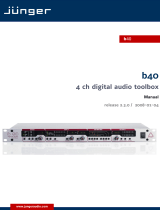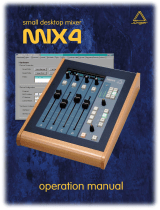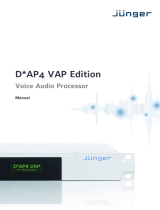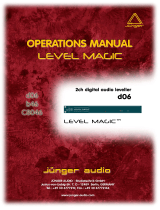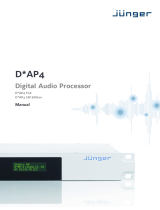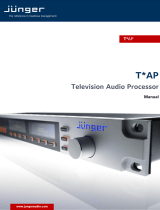Page is loading ...

www. .com
jungeraudio
b42


The information contained in this manual is subject to change without notice.
This manual is the copyright of Jünger Audio. All reproduction and copying, other than for legal owner’s
personal use, or disclosure of part or whole to a third party, is not allowed without prior written
authorization by Jünger Audio. © Jünger Audio, Berlin 1998-2004
FOREWORD
Thank you for buying and for using the 4-channel Digital
Dynamics Processor b42.
Not only you have aquired the latest generation of digital
dynamic range processing, but also a piece of equipment which
is unique in its design and specification.
Please read this manual carefully to ensure you have all the
information you need to use the 4-channel Digital Dynamics
Processor b42.
The unit was manufactured to the highest industrial standards
and went through extensive quality control checks before it was
supplied.
If you have any comments or questions about installing, setting-
up or using the b42, please do not hesitate to contact us.
0

CONTENTS
2. Function description .......................................….
2.1 Basic description ...........................................
2.2 Block diagram .............................................
2.3 Audio signal processing ................................
2.3.1 Gain ......................................................
2.3.2 Expander …………………………………
2.3.3 Deesser ………………………………….
2.3.4 Compressor ……………………………...
2.3.5 Limiter ……………...................................
2.3.6 Program …….. .......................................
2.3.7 Transparent mode ................................
2.4 The Jünger Audio Dynamics Principle ..........
2.4.1 Selection of parameters to increase
loudness ….................................................
2.4.2 Influence of signal delay time …............
3. Installation .........................................................
3.1 Unpack the unit ...........................................
3.2 Power supply ................................................
3.3 Connections ...........................…...................
3.4 Rack mounting ..........................…................
3.5 Operation safety ..........................……..........
3.6 Synchronization of digital output ..….............
3.7 Remote Control ..................……...................
3.7.1. GPI Remote Control ......…….............
3.7.2. Tally Out .............………....................
3.7.3. Serial Remote Control .......…….........
4. Location of parts and controls ............………......
4.1 Front panel ......................……......................
4.2 Rear panel ...........................………..............
4.3 Switches and jumpers for configuration ........
4.4 Selection of SDI Split Mode ......…….............
4.5 Selection of SDI audio group ........................
2-1
2-1
2-2
2-3
2-3
2-3
2-3
2-4
2-5
2-5
2-6
2-6
2-7
2-8
3-1
3-1
3-1
3-1
3-1
3-1
3-2
3-3
3-3
3-4
3-5
4-1
4-1
4-3
4-4
4-5
4-5
1

5. Operation ...............................................................................
5.1 adjustment of parameters …………………………………..
5.2 gain menu ……………………………………………………
5.3 mode menu …………………………………………………
5.4 expander menu ………………………………………………
5.5 de-esser menu ………………………………………………
5.6 compressor menu …………………………………………..
5.7 limiter menu …………………………………………………
5.8 utility menu …………………………………………………
5.9 recall and storage of presets ……………………………..
5.10 editing of presets …………………………………………
5.11 list of factory presets ……………………………………..
6. Boot display and trouble shooting ............................................
6.1 Boot display .......................................................................
6.2 Error messages and trouble shooting ................................
6.3 Initialization the unit ............................................................
7. Application notes ......................................................................
7.1 B40 series with SDI interface .............................................
7.2 Basic working modes with SDI ...........................................
8. Technical specifications ...........................................................
9. Warranty and service information ...........................................
5-1
5-2
5-2
5-2
5-4
5-4
5-4
5-5
5-6
5-6
5-7
5-8
6-1
6-1
6-1
6-2
7-1
7-1
7-1
8-1
9-1


2. FUNCTION DESCRIPTION
operation manual b40, chapter 2 -Function description- page 2-1
FUNCTION DESCRIPTION
The digital dynamics processor b42 is a professional studio
device that processes the dynamic range of digital audio
signals.
The dynamic range processor principles developed by Jünger
Audio enable compressors, limiters and expanders to be
produced with exceptionally high audio quality, without
coloration, pumping, breathing, distortion or modulation effects
sometimes associated with this type of processor.
In short, almost inaudible processing - with ease of use. The
outstanding quality of the processing is based on the Multi-Loop
dynamic range control principle developed by Jünger Audio.
The unit is easy to operate and requires only a limited number of
settings to be made by the user to achieve optimum results. All
other parameters necessary for inaudible processing are
continuously automatically controlled in response to changes in
the programme signal.
features
• 4-channel digital dynamics processor
• various link modes: 4-ch, stereo 1/2 or 3/4, ch1...4
independent
• adjustable input gain (channel independent) -15...+15 dB
• adaptive controlled dynamic range processing
expander on/off, THRS -50...-20 dBFS, REL ...
de-esser on/off, TYPE male/female, RNG -20...0 dB
compressor on/off, RATIO 1,0:1...4,0:1, RNG 0...15 dB
limiter on/off, THRS 0...-20 dBFS, PROgram 1..4
• user friendly preset and recall function (10 presets)
• pairwise bit transparent mode input to output
• extern sync mode, AES/EBU or VIDEO (or SDI if
optional SDI-interface is present)
• RS-422 interface for serial remote
• GPI interface for parallel remote control, tally output
2.1
BASIC
DESCRIPTION
2

2. FUNCTION DESCRIPTION
page 2-2 operation manual b40, chapter 2 -Function description-
2.2
BLOCK DIAGRAM

2. FUNCTION DESCRIPTION
operation manual b40, chapter 2 -Function description- page 2-3
All signal processing is done in the digital domain by Texas
Instruments floating point signal processors. The use of 32 bit word
length for calculation ensures that there is no deterioration in signal
quality, even if an audio signal with a maximum word length of 24 bit is
input into the processing of the unit.
GAIN means linear amplification of input or output signals. The input or
output gain can be changed in steps of 0.1 dB , within a range from -
15...+15 dB.
Adjustment of GAIN is channel independent.
Below an adjustable threshold level an expander can be activated
which can lower the amount of noise signals.
1:4.0
OFF
ratio
-50
-40
-30
-20
-10
[dBFS]-10-20-30-40-50-60
output
input
range
20 dB
threshold
level
-20...-50, off
The de-esser is a special processing function to reduce S-
frequencies of speakers. This can be done either by using a
compressor with frequency selective side chain, or by dynamic filtering
of voice signals.
The de-esser of the b42 uses a sophisticated dynamic filtering
algorithm for the reduction of S-frequencies. The dynamic filter makes
it possible to reduce these frequencies without influencing other
spectral parts, and works independent of the signal level.
The critical S-frequencies are different for female and male voices.
Only two basic adjustments are necessary for the de-esser - filter
frequency and the amount of s-reduction (range).
All other parameters which are necessary for effective de-esser
function are controlled by the audio signal itself.
The threshold of the de-esser is automatically set and follows the
signal power level. The reduction of S-frequencies can be controlled
by setting the range parameter from 0...-20dB.
2.3
AUDIO SIGNAL
PROCESSING
2.3.1
GAIN
2.3.2
EXPANDER
fig. 2:
static
characteristics:
expander
2.3.3
DE-ESSER

2. FUNCTION DESCRIPTION
page 2-4 operation manual b40, chapter 2 -Function description-
filter
frequency
1..14kHz incl.
male/female
S-reduction
range 0...-20
frequency
-50
-40
-30
-20
-10
[dBFS]
20k
10k1k500100
Input
level
auto
threshold
function
The compression of the programme signal takes place evenly over
the entire input level range and not only at the upper end above a
certain threshold level. Dynamic structures of the input signal (e.g.
dynamic evolutions) are converted proportionally so that even after
compression the ratios are maintained, only slightly condensed,
leaving on the whole a transparent, seemingly uncompressed sound
impression.
2.0:1
1.6:1
1.3:1
OFF
ratio
-50
-40
-30
-20
-10
[dBFS]-10-20-30-40-50-60
output
input
range
max. 15dB
Compression (reduction of the dynamic range of the input signal to
match the dynamic range of the storage or of the transmission system)
is partly achieved by increasing the level of low level signals, the
lowest of which might otherwise be below the noise floor of the audio
system.
The lower the input signal level the higher the additional gain
applied to that input signal by the compression processing will be.
fig.3:
basic function:
de-esser
2.3.4
COMPRESSOR
fig.4:
static
characteristics:
compressor

2. FUNCTION DESCRIPTION
operation manual b40, chapter 2 -Function description- page 2-5
Independent of the compression ratio , the gain of the compressor
(range) can be limited (maximum 1 dB to 15dB), so that there should
be no inadmissible increase of background noises during signal
pauses (e.g. live atmos, air-conditioning, hum and noise).
The static characteristics of the b42 usually refers to a digital output
level of 0 dBFS (dB Full Scale). This is useful for most applications of
the dynamics processor as the on-following digital recording system is
supposed to be balanced down to the final bit.
For applications using headroom the output level of can be adjusted
within 0 ... -20 dBFS in steps of 0.1 dB. The limiter threshold
determines the maximum output level.
The static characteristics fo limiter (solid) and compressor (dotted) at a
limiter threshold of -12 dBFS are illustrated in fig. 5.
audio processing of
compressor is related
to limiter threshold level
-50
-40
-30
-20
-10
[dBFS]-10-20-30-40-50-60
output
input
limiter
threshold
0...-20dBFS
max. output
level
For the dynamics functions a signal delay of approx. 2 ms is built in.
This delay makes it possible to arrange the algorithm of the limiter in
such a way that the control mechanism is activated before maximum
level is reached (look ahead limiter). Within the rise time of the signal
the peak level is recognised and the maximum is calculated in such a
way that full scale level is reached precisely without causing clipping.
For some of the control parameter it is possible to define a limited
range of time constant values which is allowed for the adaptive
dynamic range algorithms. Inside this range the time constants can be
varied by the adaptive processing. Setting the range of time constant
values may be sometimes useful, to get the best signal processing
performance regarding specific programme material.
Parameter related to the transient response of the control circuit are
important for distortionfree processing. These time constants are
allways adaptive controlled without remarkable limitation of parameter
range. This is caused by the presence of transient pulses in allmost
2.3.5
LIMITER
fig. 5:
basic function:
limiter
2.3.6
PROGRAM

2. FUNCTION DESCRIPTION
page 2-6 operation manual b40, chapter 2 -Function description-
each kind of programme material. The algorithm has to guarantee best
reaction for fast increasing level of transient signals anytime even if
classical music with slow dying out characteristic is processed. In all
cases the attack time of the limiter for very short transients is zero.
Especially the release time of the control circuit has more influence to
the increase of loudness as any other parameter. The ranging of time
constants in processing time groups reflects this fact. The range for
processing time shows influence on release time parameter mostly.
The selection of the parameter PROGRAM changes the range of time
constant values as follows:
PRO processing time corresponds to
preset
----------------------------------------------------------------------------------------------
0 2 ms to 0.2 sec
1 5 ms to 0.5 sec LIVE
2 10 ms to 0.8 sec
3 15 ms to 1.2 sec SPEECH
4 30 ms to 2.5 sec POP
5 50 ms to 3.5 sec
6 70 ms to 5.0 sec UNIVERSAL
7 100 ms to 6.0 sec
8 150 ms to 8.0 sec CLASSIC
9 250 ms to 10.0 sec
In case that the input signal (audio pair 1/2 or/and 3/4) is not audio (but
AC-3, Dolby E, MPEG..) the input can be feeded directly to the related
output bit transparent (no bit changes). The unit is switching to
transparent automatically if “non audio” flag in the Channel Status Bit
of the AES signal is set. Otherwise transparent mode can be set
manually by the user.
A change in the dynamic range of an audio signal is a non-linear
process. The gain of a dynamic range processor is not constant as it is
with the gain of a linear amplifier. The gain varies in time depending on
the input signal and depending on the specific control algorithm of the
dynamics processor. These variations in the gain, which represent the
real control process, should take place without any bothersome side
effects.
The dynamic range processor principle developed by Jünger Audio
makes it possible to realise dynamics processors (compressor, limiter,
expander) with very high audio quality, without signal discolouration,
pumping or breathing, without distortion and modulation products - in
short, with almost inaudible processing - and they are very easy to use.
The Jünger Audio dynamics processors work according to a Multi-
loop principle, operating with an interaction between several
frequency linear control circuits. This is quite different to the popular
multiband structure which changes the sound.
The resulting attack and release times of the Multi-loop-system are
variable and adapted to the evolution of the input signal. This allows
relatively long attack times during steady-state signal conditions but
also very short attack times when there are impulsive input transients.
2.3.7
TRANSPARENT
MODE
2.4
THE JÜNGER AUDIO
DYNAMICS
PROCESSOR
PRINCIPLE

2. FUNCTION DESCRIPTION
operation manual b40, chapter 2 -Function description- page 2-7
The Multi-loop structure also permits a short time delay between the
control circuit and the gain changing element. The gain control circuit
has time to preview the signal and become active before it reaches the
output. This is particularly important for the limiter, which provides a
precisely leveled output signal absolutely free of overshoots (clipping).
Signal compression and the loudness enhancement of the digital
audio signal can be achieved by combining two dynamic range control
processes: firstly, the compression achieved by increasing small and
medium signal levels and secondly, linear amplification combined
with the inaudible limitation of individual, remaining peak levels with
the limiter.
In the gain change mode the operation of compressor and limiter can
be observed on the display. For smaller signal levels the compressor
causes additional amplification which however decreases the higher
the signal level is . With full scale levels the compressor is practically
ineffective so that even an increase of the RATIO will have no effect.
If you now increase the linear amplification GAIN, individual peak
levels are raised above the limiter threshold and limited inaudibly. All
other signal components can however be increased. If the gain is too
large also medium levels are treated by the limiter, which means that
the limiter then reduces the signals continually and again reduces the
additionally applied amplification.
The display for Limiter-Gain-Reduction should be in the region of 0....-6
dB and should not light up red continuously, so that a dynamic
limitation only applies to signal peaks.
Then the signal compression and therefore also the increase of
loudness is at its most effective.
2.4.1
SELECTION OF
PARAMETERS TO
INCREASE
LOUDNESS
A A
f
delay
1
1
2
2
n m
f
Multi - Band Multi - Loop

2. FUNCTION DESCRIPTION
page 2-8 operation manual b40, chapter 2 -Function description-
The audio signal delay through the dynamics processor is approx.
2ms due to delaying of the audio signal using internal memory. A
small delay is deliberately introduced to the audio signal in order to
allow limiter and compressor algorithms which can 'preview' the
audio signal before changing it. That is the signal curve can be
changed before maximum level is reached. This delay must be
considered before attempting to mix signals processed by the
dynamics processor with other undelayed signals.
When mixing together a delayed signal and a direct signal there may
be cancellation of the signal waveform at some frequencies and re-
inforcement of the waveform at other frequencies (comb filter effect).
Corresponding 2ms delay of direct signals should therefore be
carried out before mixing them with delayed processed signals.
2.4.2
INFLUENCE OF
SIGNAL DELAY
TIME

3. INSTALLATION
Operation manual b42, chapter 3 -installation- page 3-1
INSTALLATION
The digital dynamics processor b42 was carefully packed in the
factory and the packaging was designed to protect the
equipment from rough handling. Please examine carefully the
packaging and its contents for any signs of physical damage,
which may have occured in transit.
The digital dynamics processor b42 is a device under the safety
category Schutzklasse 1 in keeping with the VDE 0804
standards and may only used with power supply installations
built according to regulations.
Check the voltage details printed at the rear panel are the same
as your local mains electricity supply.
The dynamics processor b42 is equipped with standard
connectors (see also chapter 3).
Before connecting the digital dynamics processor b42 switch the
power off at all connected units.
The digital dynamics processor b42 is made as standard 19“ unit
(EIA format). It occupies 1 RU (44 mm height) space in a rack.
Please allow at least additional 3“ depth for the connectors on
the rear panel.
When installing the unit in a 19“ rack the rear side of the unit
needs some support, especially for mounting in flight cases.
The digital dynamics processor b42 should not be installed near
units which produce strong magnetic fields or extreme heat. Do
not install the filter processor directly above or below power
amplifiers.
If, during operation, the sound is interrupted or displays no longer
illuminate, or if abnormal odor or smoke is detected immediately
disconnect the power cord plug and contact your dealer or
Jünger Audio.
3.1
UNPACK THE UNIT
3.2
POWER SUPPLY
3.3
CONNECTIONS
3.4
RACK MOUNTING
3.5
OPERATION
SAFETY
3

3. INSTALLATION
page 3-2 Operation manual b42, chapter 3 -installation-
The digital dynamics processor b42 has a digital signal output
only. To the problem-free combination of following digital devices,
the digital signal processing can be locked to an external clock
reference. The selection of the corresponding input is made in
the SYNC MODE menu. If the chosen sync input is connected
with the sync signal, this signal is used for synchronization
automatically. The digital output signal can be clocked with the
following clock frequencies:
CH 1/2 locks with the clock frequency of the input signal at
digital input CH 1/2 (AES/EBU, 48 kHz)
EXT SYNC locks with the clock frequency at the
external sync input (AES/EBU, 48 kHz)
VIDEO locks with the clock at the Video sync input
(internal 48 kHz)
SDI VIDEO locks with the clock at the SDI input
(internal 48 kHz)
Both digital outputs CH 1/2 and CH 3/4 are locked with same
clock frequency.
Note: SDI sync is available only if SDI interface is installed!
The digital dynamics processor b42 can be remote-controlled by
means of parallel GPI contacts.
use : remote-controlled changeover of presets
connector: D-SUB 15pin, female
Pin assignments
Pin Signal name Logic I/O Functions
1 PRESET1 H I recall preset1
2 PRESET2 H I recall preset2
3 PRESET3 H I recall preset3
4 PRESET4 H I recall preset4
5 PRESET5 H I recall preset5
6 PRESET6 H I recall preset6
7 PRESET7 H I recall preset7
8 PRESET8 H I recall preset8
9 MUTE H I Muting outputs
10 BYPASS H I bypass on
11 not used
12 not used
13 not used
14 Common pin External ground
15 +5V O Test power source
3.6
SYNCHRONIZATION
OF
DIGITAL OUTPUT
3.7
REMOTE
CONTROL
3.7.1
GPI REMOTE
CONTROL
(PARALLEL
REMOTE)

3. INSTALLATION
Operation manual b42, chapter 3 -installation- page 3-3
Electrical specification:
GPI input potential free by opto-coupler, low active
OFF: +3.5…+30V between GPI input
and pin14
ON: less then 1.5V
Min 50ms
Note: If using an external voltage feed it has to be connected to pin 14!
External Ground is switching the GPI on any of the inputs.
An internal voltage feed is available on pin 15. Ground is available from the
shield of the connector only! By using the internal voltage feed there is no
electrical isolation given anymore.
The digital dynamics processor b42 can transmit specific device
statuses via parallel Tally lines.
use: Control of the remote-controlled changeover of
presets
connector: D-SUB 15pin, male
3.7.2
TALLY OUT
min. 50 ms
+1,5V
+3,5...30V
Pin1...13
Ext. voltage
feed+3
,
5...30V
Pin14
Contact to
ext. Ground

3. INSTALLATION
page 3-4 Operation manual b42, chapter 3 -installation-
Pin assignments
Pin Signal name I/O Functions
1 T1 open contact O preset1 recalled
2 T2 open contact O preset2 recalled
3 T3 open contact O preset3 recalled
4 T4 open contact O preset4 recalled
5 T5 open contact O preset4 recalled
6 T6 open contact O preset4 recalled
7 T7 open contact O preset4 recalled
8 T8 open contact O preset4 recalled
9 T9 open contact O mute
10 T10 open contact O bypass
11 T11 open contact O Not used
12 T12 open contact O Not used
13 T13 open contact O Not used
14 T14 open contact O Not used
15 root Common root contact
Electrical specification:
Tally output type: normally open relais contacts
Contact rating: 1A 24 VDC, 0,5 A 125 VAC
max. 30 W 62,5 VA
max. 60 VDC, 125 VAC
Pin1...14 Tally output
Open contact
Pin15 Common root
contact

3. INSTALLATION
Operation manual b42, chapter 3 -installation- page 3-5
The digital dynamics processor b42 can be remote-controlled by
means of serial remote RS-422.
use : remote-controlled changeover of presets
protocol: available on request
connector: D-SUB 9pin, input - female
output - male
Pin assignments
The cable is wired 1:1 completely, the shield of the cable must be connected
on both ends!
REMOTE IN
Pin Signal name Functions
1 DSR + out Data set ready
2 DSR - out
3 SENSE in Interrogation Remote
4 RXD + out Receive data
5 RXD - out
6 DTR + in Data terminal ready
7 DTR - in
8 TXD + in Transmit data
9 TXD - in
REMOTE OUT
Pin Signal name Functions
1 DSR + in Data set ready
2 DSR - in
3 GND GND
4 RXD + in Receive data
5 RXD - in
6 DTR + out Data terminal ready
7 DTR - out
8 TXD + out Transmit data
9 TXD - out
Electrical specification:
signal in-/outputs TTL-level
3.7.3
SERIAL REMOTE
CONTROL
(RS-422)

/
